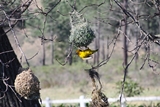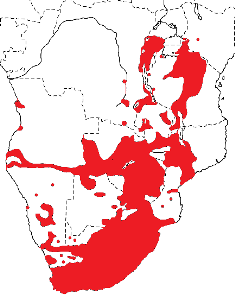Weaver species
Choose different species from drop-down list and press 'Go' button. See Full species list.Southern Red Bishop Euplectes orix
IUCN: Least concern Discovery: 004Categories: wetland, red bishops, gum, Linnaeus, nectar, pest, Nest use, palm, blue eggs,
News items about species
Discovery
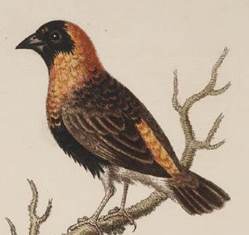
figure from Edwards 1751 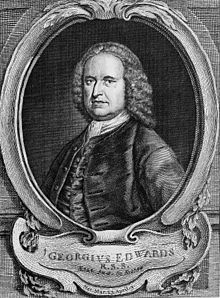
painter of Southern Red Bishop type, figure from wikipedia 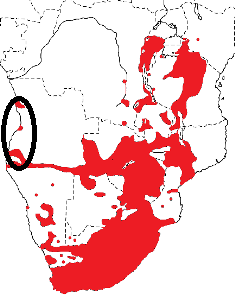
type locality circled IntroductionLinnaeus based his species description on the publication of George Edwards. Linnaeus listed the type locality as Africa interiore.Edwards etched a copper engraving of the male from a living bird in the Greenwich aviary of George Shelvocke, Secretary to the Right Honourable the Earl of Leicester, Post-Master General (this Shelvocke is not the better known English Royal Navy officer). Shelvocke acquired a large collection of birds from Lisbon, the Southern Red Bishop having been shipped there from Angola. Edwards called it the Grenadier, after the Portuguese name Grenidiere, but probably referring to the red and black colours of the breeding male Southern Red Bishop which resembled the red uniforms and black headdress of the British Grenadiers. The first published reference to the Southern Red Bishop was long before Linnaeus or Edwards wrote about it. Johann Schreyer, a German soldier, arrived in the Cape of Good Hope (Cape Town) in 1668 and stayed for several years to work as a surgeon. He wrote a book (Schreyer 1681) and described many birds and animals, with some illustrations (but not of the bishop), and wrote of one bird: "as red as a glowing ember and the belly like fine black velvet, and live by the brooks". Of all the birds in Cape Town, only the Southern Red Bishop fits this description. This is one of the earliest published references to any weaver. Scientific citationEmberiza orix Linnaeus 1758 Syst. Nat., ed. 10, p.177 Interior of Africa (Angola, ex Edwards, 1751, Nat. Hist. Birds, 4, pl. 178).Meaning of namesorix (Latin oryza = rice); refers to the diet of the Red Bishop, which feeds on grain and seeds.First English nameThe Grenadier (Edwards 1751)Alternate namesRed Bishop, Grenadier Bishop, Scarlet Bishop.CollectorUnknown, sent to Lisbon, where purchased by George Shelvocke.Date collectedBefore 1750, when Edwards painted the bird.Locality collectedAngolan coast.Type specimensNo type specimens known to survive, but the painting of Edwards serves as a type. |
The above is based on Weaver Wednesday 2, a weekly series about the discovery of each weaver species.
This species text first appeared as
Weaver Wednesday [121] - Discovery [4]: Southern Red Bishop on 2014-10-08
1. Basic biology
 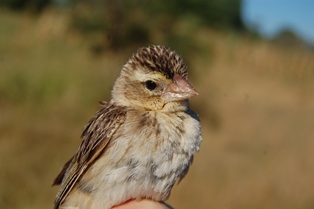
Identification The Southern Red Bishop Euplectes orix breeding male is brightly coloured with black and red, and has a short tail. The combination of black mask and abdomen, with the crown, throat, breast, rump, upper and under tail coverts red, distinguishes the Southern Red Bishop from other red and black bishops. Females, non-breeding males and young birds are dull coloured and difficult to distinguish from other bishops and widows. The Southern Red Bishop was well known to early travellers and writers. For instance, in 1816 George Shaw wrote: "This species is gregarious, and builds its nest in large societies, among the reeds, near the rivers and ponds in the vicinity of the Cape of Good Hope and St. Helena: the appearance of these birds among the reeds is said to have a most beautiful effect, from the brilliancy of their colours."
Distribution The Southern Red Bishop is a conspicous wetland species in southern and East Africa (see map below, based on Birds of Africa). Several subspecies of the Southern Red Bishop have been proposed in the past, but none are currently recognised since populations are not reliably separable on measurements nor on plumage characters. It has also been introduced to several countries, eg Australia (see here) and St Helena (unsuccessfully). Habitat This species has increased in numbers due to the building of dams and irrigation canals, and expansion of seed crops. Numbers are reduced, however, where wetlands are drained. Food The Southern Red Bishop feeds mainly on seeds, and also on insects in summer and when feeding young. 24 seed species, mostly small, were recorded in the Free State, South Africa. Chicks are fed on arthropods including dragonflies, beetles, caterpillars and spiders, and eggshell fragments have been found in chick stomachs. It is a significant crop pest in wheat fields in the south-western Cape, South Africa, where up to 70% of the crop may be destroyed in some fields. Birds generally forage in two sessions daily, morning and late afternoon, and gather in day roosts during the middle of the day. The oldest bird is over 13 years (see here). Breeding The Southern Red Bishop is polygynous, with up to 7 females nesting in a male's territory at any one time, and up to 18 females in a breeding season. It is colonial, with colonies of several hundred nests in reeds; nests are also found in small groups and sometimes a pair nests solitarily. The nest is an oval, with a side entrance under a porch near the top. The nest is tightly woven of thin strips of reed or grass blades, and lined with plant down and grass seed heads. The nest is built by the male and may be completed in a single day, but usually takes 2-3 days. Initially eggs are visible through the weaving, but as the female adds lining during incubation the nest walls become opaque. The average clutch size is 3 eggs, but the mean clutch size is larger in years of heavier rainfall. The female incubates for only 40% during the day, with bouts in the nest of 1-10 minutes and absences of 1-12 minutes.   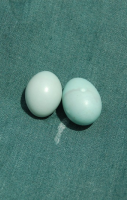 Some nest predators that have been recorded are water monitor, egg-eating snake, rats, slender mongoose, Cattle Egret and White-browed Coucal. Old nests used by Tawny-flanked Prinia Prinia subflava, Zebra Waxbill Sporaeginthus subflavus and other species. Climbing mice Dendromus mesomelas take over old nests of weavers, including the nests of Southern Red Bishops. The Southern Red Bishop is a major host to the Diderick Cuckoo Chrysococcyx caprius but high rates of brood parasitism are found only at small colonies where all the territory-holders may be absent at the same time (see here). |
The above is based on Weaver Wednesday, a weekly series about weaver species.
This species text first appeared as
Weaver Wednesday [40]: Southern Red Bishop on 2013-03-20
2. Breeding facts
| Pair bond highly polygynous, up to seven females nesting on a male teritory at one time, and one male having up to 18 social mates in single breeding season Breeding season Apr-Jun in Uganda and Kenya, Jan-Apr in Angola and DRCongo, Mar-May in Rwanda, Feb-May in Tanzania, Dec-Apr in Zambia and Malawi, Feb-Mar in Mozmbique, Feb-May in Namibia, and Dec-Mar in Botswana and Zimbabwe; in South Africa, Jul-Dec in winter-rainfall region of Western Cape, Oct-Mar/Apr in other regions Nest site most often placed in reeds, sedges or bulrushes (Typha) standing in water,in Phragmites reedbeds often 2 m above water, but sometimes in maize or other crops in fields, in bamboo or Indigofera thickets, or even in privet (Ligustrum) hedges Nest building built by male, female adds lining Colony size Often in dense colonies of several hundred birds in reedbeds Clutch size typically 3 eggs (mean of 670 clutches in South Africa), some clutches double normal size presumed result of two females laying in same nest Egg colour pale bluish-green to turquoise, rarely with few dark spots Egg size average size of 268 eggs 19.2 x 14.1 mm (South africa) Incubation incubation by female only, in KwaZulu-Natal (South Africa) eggs covered for only 40% of daylight hous, incubation period 12-13 days Chicks and nestling period chicks fed by female, primarily by regugitation, with seeds from early stage, nestling period 11-15 days, young liable to leave nest after 10 days if disturbed |
Breeding information based on Handbook of the Birds of the World, Vol. 15.
3. Photos of Weaver Nests
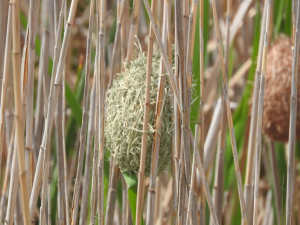 Vm 30914 | 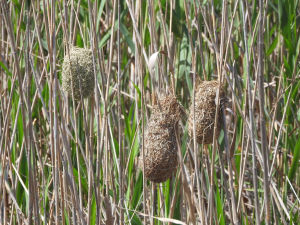 Vm 30912 |  Vm 30885 |  Vm 30869 |  Vm 30518 |  Vm 30498 |
Thumb-nails of most recent PHOWN records - click on one to see its full record
See all PHOWN records for this species here.
PHOWN (Photos of Weaver Nests) provides valuable info on breeding distribution and colony sizes of weavers.
You can contribute by registering and submitting photos at Virtual Museum webpage.
4. Breeding distribution
Google map showing distribution (For species with small ranges you need to zoom in at the correct area to see the range):
yellow blob - range of weaver species; read more about this here.
![]() - PHOWN records with photos
- PHOWN records with photos
![]() - PHOWN records with no photos (Nest Record Cards, other records)
- PHOWN records with no photos (Nest Record Cards, other records)
![]() - Birdpix records
- Birdpix records
![]() - comments on out of range records, or interesting records
- comments on out of range records, or interesting records
![]() - type locality
- type locality
CLICK on the marker on the map to see individual record details.
5. Range changes
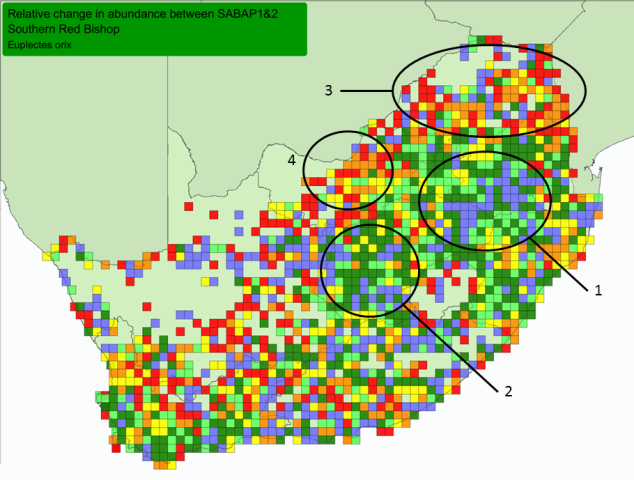
Red, orange and yellow = cells with very large, large, and small relative decreases Blue, dark green and light green = cells with very large, large and small relative increases. Cells = quarter-degree grid cells; Only cells with at least 4 checklists in both SABAP1&2 shown. All cells had this species recorded in SABAP1 or in SABAP2 or in both (more about interpretation at Biodiversity Observations 7.62: 1-13).
Range changes in SA
The points below match the points on the map above. Areas with very large increases include:
Areas with very large decreases include:
Many areas in South Africa show a checkered pattern, suggesting small changes (ie stable populations). Range changes elsewhereExotic populations established in foreign countries, eg United Arab Emirates, Australia: Appendix of Dyer EE, Redding DW, Blackburn TM. 2017. The global avian invasions atlas, a database of alien bird distributions worldwide. Nature Scientific Data 4 no: 170041. | |||||||||||||||||||||||||||||||||||
The above is based on Weaver Wednesday 3, a weekly series about range changes in South African weaver species.
This species text first appeared as
Weaver Wednesday 3 [255] - Range changes [18]: Southern Red Bishop on 2017-05-03








